Thursday, August 20th, 2009
Phrygian Caps in Art
Yesterday I was reading about Delacroix’s Liberty Leading the People (1831) and started to think about the Phrygian cap that Liberty is wearing. The Phrygian cap is a soft, conical, red cap was traditionally worn in ancient Phrygia (modern day Turkey). In ancient Greek art, these caps were used as headdresses for people from the Orient. Eventually, the Phrygian cap developed into a symbol of freedom and liberty – they were worn by emancipated slaves in ancient Rome. In the eighteenth century, the Phrygian cap became popular with the French revolutionaries and subsequently was known as the “cap of liberty.” (The Phrygian cap has even been used as part of the official seal for the United States Senate.) This is a detail of Liberty wearing a Phrygian cap in Delacroix’s painting:
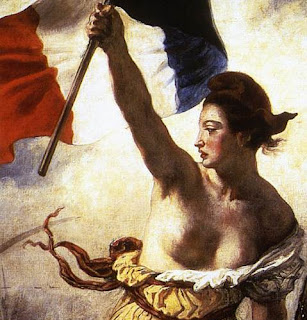
This cap made me think of my thesis, in which I argue that Aleijadinho’s Prophets (1800-1805) composition is laced with abolitionist sentiment. I briefly mentioned that the clothing of the prophet Amos could allude to abolition (it is possible that Afro-Brazilian capoeiristas wore similar outfits at the time the sculpture was created), but I didn’t consider Amos’ cap until now:
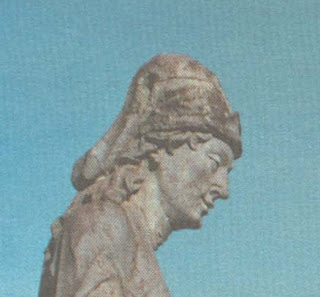 I wonder if this cap could have been influenced by the Phrygian cap. Part of my thesis ties in these statues to the political/revolutionary sentiment of the day, since these statues were created relatively soon after the 1789 French Revolution. Could Aleijadinho have been influenced by the Phrygian cap of the French revolutionaries? At first glance, it seems to me like Amos’ hat might be too long to be a Phrygian cap. I’m curious about looking at my photo archives, though, to see if I can see his cap in better detail. Interestingly, people have written about how the “turbans” of Aleijadinho’s Prophets seem to be influenced by Turkish costume (which perhaps could be a connection to Phrygia instead?).
I wonder if this cap could have been influenced by the Phrygian cap. Part of my thesis ties in these statues to the political/revolutionary sentiment of the day, since these statues were created relatively soon after the 1789 French Revolution. Could Aleijadinho have been influenced by the Phrygian cap of the French revolutionaries? At first glance, it seems to me like Amos’ hat might be too long to be a Phrygian cap. I’m curious about looking at my photo archives, though, to see if I can see his cap in better detail. Interestingly, people have written about how the “turbans” of Aleijadinho’s Prophets seem to be influenced by Turkish costume (which perhaps could be a connection to Phrygia instead?).
It will be interesting to follow up on this idea and see if it leads anywhere. In the meantime, though, here are a couple of other depictions of Phrygian caps in art:
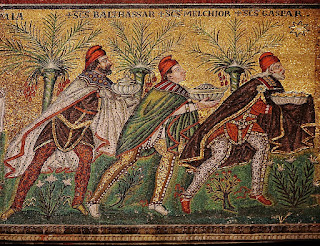 The Three Magi (Balthasar, Melchior, and Gaspar), mosaic at Sant’Appollinare Nuovo (6th century); Ravenna, Italy
The Three Magi (Balthasar, Melchior, and Gaspar), mosaic at Sant’Appollinare Nuovo (6th century); Ravenna, Italy(In this instance, the Phrygian cap indicates the that the wise men are from the Orient, not that they are emancipated slaves!)
 Berthel Thorvaldsen, Ganymede Waters Zeus as an Eagle (1817)
Berthel Thorvaldsen, Ganymede Waters Zeus as an Eagle (1817)
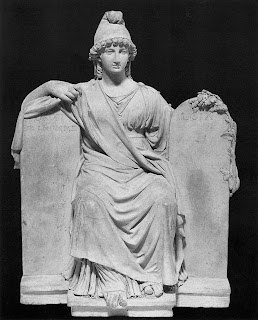 Joseph Chinard, The Republic (1794)
Joseph Chinard, The Republic (1794)
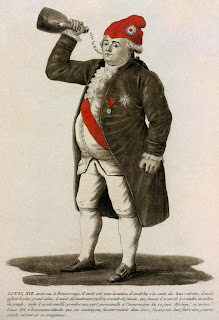 Anonymous, Louis XVI of France Wearing a Phrygian Cap, 1792 (Library of Congress)
Anonymous, Louis XVI of France Wearing a Phrygian Cap, 1792 (Library of Congress)
The phrygian cap is all over the place once you start looking at it. You might be interested in reading "The Liberty Cap as a Revolutionary Symbol in America and France" by Yvonne Korshak (Smithsonian Studies in American Art, Vol. 1, No. 2 (Autumn, 1987), pp. 53-69). It's all about how the Americans actually started using the Phryngian cap as a symbol of slavery first, and then the French picked it up for their revolution. And the Statue of Liberty was originally designed to wear a phryngian cap, but by then the symbol had changed in America to have negative connotations.
Wow, now that I know, I feel like I've seen these on statues all over the place. Seriously, the things I learn because of you. Impressive!
Thanks for pointing out this article, heidenkind! I downloaded it off of JSTOR and have already started to read it. It's quite fascinating to read about how the symbol was first used in America. How cool.
Yeah, e, I bet you see liberty caps all over Washington DC. If you see any in cool/unusual places, I'd love to hear about them!
I'm fascinated by your thoughts on the Aleijadinhos prophets. Surely the liberty cap in this context means … just that! How appropriate for prophets! If I'd known about them I might well have cited them in my article mentioned by heidenkind in your first comment.
I'll be watching Alberti's Window with interest. Perhaps you'll take a look at my blog, too — on a different topic — http://www.LetsTalkOff-Broadway.com
Sincerely,
Yvonne Korshak
Yvonne Korshak, thanks so much for your kind comment! I'm very encouraged (and flattered) that you like my idea. I hope to keep following up on this research topic, and perhaps include this idea in an upcoming publication.
Your theater and film blog looks quite fun, too. I'll be sure to visit it regularly.
I just came across another Phrygian cap. Bellona, the goddess of war, is depicted wearing a Phrygian cap on Francois Rude's La Marseillaise. This sculpture is located on the Arc de Triomphe in Paris. (I should have examined this sculpture for a Phrygian cap earlier, especially since it's a contemporary with Delacroix's Liberty Leading the People.
This is an interesting article on this this site. Check out the rest of the articles.
Phrygian Cap, Liberty Cap; The Orgins!